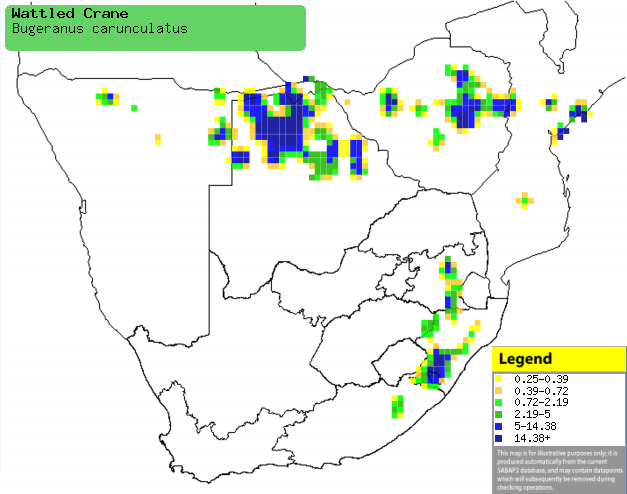|
Bugeranus carunculatus (Wattled
crane)
[= Grus carunculatus]
Lelkraanvoël [Afrikaans]; Igwampi, Iqaqolo [Xhosa]; uBhamukwe
[Zulu]; Epanda [Kwangali]; Motlathomo [South Sotho]; Jowori [Shona]; Nyakukolwe
[Tsonga]; Lelkraanvogel [Dutch]; Grue caronculée [French]; Klunkerkranich
[German]; Grou-carunculado [Portuguese]
Life
> Eukaryotes >
Opisthokonta
> Metazoa (animals) >
Bilateria >
Deuterostomia > Chordata >
Craniata > Vertebrata (vertebrates) > Gnathostomata (jawed
vertebrates) > Teleostomi (teleost fish) > Osteichthyes (bony fish) > Class:
Sarcopterygii (lobe-finned
fish) > Stegocephalia (terrestrial
vertebrates) > Tetrapoda
(four-legged vertebrates) > Reptiliomorpha > Amniota >
Reptilia (reptiles) >
Romeriida > Diapsida > Archosauromorpha > Archosauria >
Dinosauria
(dinosaurs) > Saurischia > Theropoda (bipedal predatory dinosaurs) >
Coelurosauria > Maniraptora > Aves
(birds) > Order: Gruiformes >
Family: Gruidae
Distribution and habitat
Occurs in Ethiopia as well as the area from Zambia,
southern DRC and Malawi to southern Africa. Here it is uncommon to rare in
north-eastern Namibia (including the Caprivi Strip), northern Botswana, central
Zimbabwe and Mozambique, Mpumalanga and KwaZulu-Natal. It generally prefers
fairly shallow wetlands with emergent vegetation, or surrounded by grassland or
miombo (Brachystegia) woodland, sometimes moving to man-made dams and
cultivated fields.
|
 |
|
Distribution of Wattled crane in southern Africa,
based on statistical smoothing of the records from first SA Bird Atlas
Project (©
Animal Demography unit, University of
Cape Town; smoothing by Birgit Erni and Francesca Little). Colours range
from dark blue (most common) through to yellow (least common).
See here for the latest distribution
from the SABAP2. |
Predators and parasites
- Predators
- Parasites
- Leucocytozoon grusi (haematozoan parasite)
Movements and migrations
Complex, as it is resident in some areas (such
as much of South Africa and the Magango Game Reserve and Mamili
National Park in Namibia), while it may move into other regions if there is a lot of rainfall. For example it is most common at
the Okavango Delta in the period from April-August.
Food
Mainly eats seeds and tubers supplemented with small animal
prey, doing most of foraging by touch, digging with its beak in moist soil or
shallow water. The following food items have been recorded
in its diet:
- Plants
- tubers of sedges
- grass seeds
- Animals
- small aquatic snails
- fish
- frogs
Breeding
- Monogamous, solitary nester, with breeding pairs performing dancing
courtship and recognition displays.
- The nest (see image below) is built by both sexes, consisting of a mound
of aquatic vegetation with a central cup, often surrounded by a moat of open
water. It may also use a submerged rock in a stream, a grassy hollow in an
islet, flooded anthills on a dam or an old
Spur-winged goose
nest.
 |
|
Wattled cranes at their nest, Mpumalanga, South
Africa. [photo Warwick Tarboton ©] |
- Egg-laying season is year-round, peaking from April-September.
- It lays 1-2 eggs, which are incubated by both sexes for about 31-40
days.
- The chicks are precocial, leaving the nest soon after hatching, although
staying close for about three weeks, at which point the parents lead them
further away. At first the chicks are extremely aggressive to each other,
often resulting in mortality. They return to the nest every night to roost
until they are about 100 days old, taking their first flight at about 90-130
days old. They become fully independent roughly 7-12 months
later, driven away by their parents so that they join a non-breeding flock
before the following breeding season.
Threats
Globally Vulnerable, while Critically endangered
in South Africa, mainly caused by wetland destruction and degradation, as
well as damming, afforestation, trampling of nests, overgrazing, housing
development, too frequent fires and other forms of human disturbance.
References
-
Hockey PAR, Dean WRJ and Ryan PG 2005. Roberts
- Birds of southern Africa, VIIth ed. The Trustees of the John Voelcker
Bird Book Fund, Cape Town.
|
